The Embankment
With the help of mana whenua, Gladstone School has drawn on ancestral links to redevelop an underused space into a place of deep value and connection.
“The embankment now is a place where students can continue to connect with nature in a practical way and learn about te taiao and te ao Māori through actions, te reo and tikanga,” says Whaea Micaela, hub teacher and lead on curriculum integration of te ao Māori at Gladstone School.
A history of action
The “embankment” at Gladstone School runs alongside a fenced-off and highly modified stream that dissects Gladstone School. The bank has been the focus of many one-off plantings and mini projects (like the quickly overgrown lizard garden) since Gladstone School became an Enviroschool in 2003.
So what changed in order to transform this out of bounds place into one where “students are grounded with Papatūānuku, where they can learn incidentally and naturally”?

Whānau and tamariki preparing for more planting at a working bee July 2021.
Linking with mana whenua underpins the action with a deeper kaupapa
The embankment became a focus for learning within the school again in 2020 as part of the school’s development of local curriculum. This time it was more than a project. The emphasis was on creating a space for students to have genuine environmental experiences within the school grounds in an ongoing way.
“If we want students to have agency they first need to experience.”
The direction was underpinned by a deep philosophical approach grounded in kaupapa Māori, with the support of the local marae and the Ngāti Kahungunu curriculum and resources. The local marae committee supported the school to develop appropriate tikanga for welcoming people. The school also worked with the marae to revitalise some tukutuku panels.
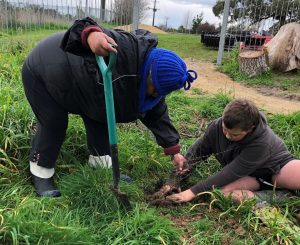
After offering karakia for the day, Nanny Francis from Hurunui-o-Rangi marae helps with the planting mahi.
“It’s a close relationship we have with the school. We went there as kids and it is our community,” says local kuia Nanny Francis.
With the guidance of the Ngāti Kahungunu environmental officer and member of the local hapū, Ra Smith, staff took bus tours to local places and classes investigated the local waterways of significance. Their newly formed multi-level learning hubs have been named after the highways of our tuna kuwharuwharu linking their local hills to the sea: Ruamahunga, Kourarau and Onoke.
Weaving connection to te taiao into the fabric of the school
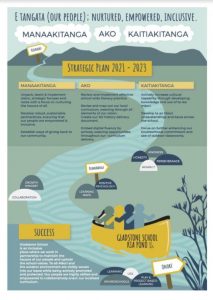
Gladstone School’s strategy: E tangata (Our people) – developed in conjunction with local marae committee members
These names have been woven into the school’s strategic plan as part of a full school and community mapping and visioning process. Members of the marae committee were part of this process and contributed to the visual elements of the strategy. The names created an even deeper connection to water, building on learning that had already taken place.
The embankment area alongside the waterway in the school grounds provides an ideal place to integrate action for water, regularly. The Ruamahanga hub took on weeding, visioning and developing the embankment area. They created paths and have further plans for insect homes and places for fish to hang out. This motivated some committed students to work in the area in their spare time, extending the pathways and making sure the stream was protected from erosion.
Further planting was needed. Gladstone School received funding from the Matariki Tu Rākau Trust which invites recipients to name the plantings after community members who had made significant contributions.
Honouring our ancestors
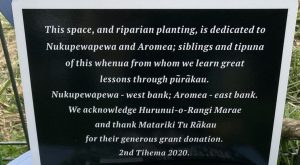
Plaque installed at the opening to acknowledge Nukupewapewa and Aromea.
Consulting with the local marae committee, the school decided to name the two areas of the embankment after Ngāti Kahungunu ancestors Nukupewapewa and his sister Aromea. The students designed and painted pou in honour of the ancestors and, at the official opening of the embankment area, acted out the stories of the ancestors. Nukupewapewa was a clever leader with a thirst for learning, showing ingenuity and skill in war. Aromea, a leader in her own right, worked along Nuku helping him reach his potential and understand leadership.
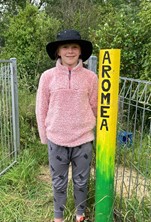
A pou representing Aromea, the ancestor after whom the east bank is named.
Nanny Francis, much loved kuia from local hapū, speaks of her pride in the action taking place around the waterway and is excited about a project with the local council trying to uncover the name for the waterway.
Maintaining momentum
In July 2021, the school community, young and old, came together for a working bee to support the students to maintain and further plant this area. Greater Wellington Regional Council Take Action Biodiversity Fund and the Ruamahanga Restoration Trust provided further funding for planting and materials.
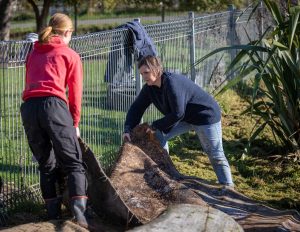
Principal, Belinda Bunny, and an ex-pupil reuse old carpet as mulch.
The momentum continues as the school now places value on this place as part of their local curriculum. It is a place where students can connect with Papatūānuku and be reminded of appropriate tikanga to use as whānau of the living environment. It provides a way to connect to those who have come before who may have guidance for us in the future.
Whaea Micaela hopes that one day this beautiful area will be a place that students engage with daily, with support from a specialist kaiako who weaves experiential learning and action using a Te Ao Māori lens.
Asked what she is hoping for in the future, Nanny Francis says, “Keep it flowing.”
This and other mahi make Gladstone School a strong role model in the Enviroschools community in the Wairarapa. Principal Belinda Bunny says that Enviroschools helps the kura to view the world in a culturally responsive, environmentally friendly way.
“Facilitators wrap around our school to support sustainable, engaging initiatives that nurture, empower and include everyone associated with our community.” – Belinda Bunny, Principal
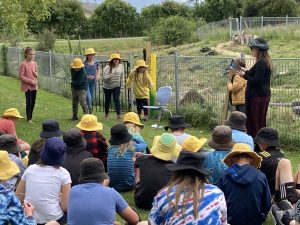
Ruamahanga tamariki act out the pūrākau of Nuku and Aromea.
Banner image: School community enjoying the embankment area